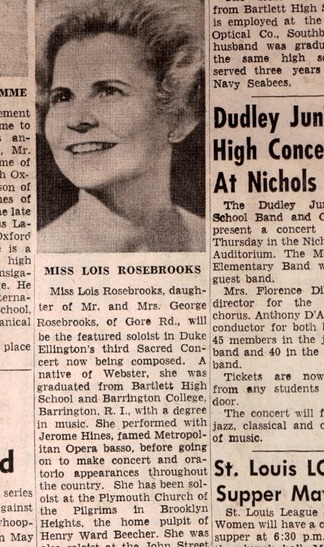It’s a lake whose name even locals have trouble pronouncing. Commonly known as Webster Lake
It’s a
huge body of water and according to the Webster Times has the longest
name – 45 letters -- of any lake in America
Before it was destroyed by fire on
Ellington memorialized this once great Nipmuc fish hole in song. Although never recorded and remains in his book of unpublished pieces, the great American composer dubbed his tune, “Chau-go-ga-gog man chau-ga-gog chau buna-gung a maug.”
It was written around the same time as the bandleader’s appearance at the pavilion. Unfortunately, another song about the large pond was published before Ellington’s.
That song, "The Lake Song: By Lake Chargoggagoggmanchauggagoggchaubunagungamaugg" was a minor hit for Fred Waring and his Pennslyvanians. It was penned by Will Heagney, Will Mahoney and Bert Reed and first published by the Harry Von Tilzer Music Company. Von Tilzer is the author of "Take Me Out to the Ballgame."
Another song about the lake was recorded by Ray Bolger and Ethel Merman for the Decca label in the 1950s. That tune is titled, "The
 |
| A young Ethel Merman |
Possibly deterred by the success of the other 1930's song, Ellington left his
Daughter Introduces Mother to Duke.
In the
1960s, Mrs. Rosebrooks', daughter, Lois M. Rosebrooks, was a professional
singer who had performed with Ellington in his revered
sacred concerts.
In 1971,
the Duke Ellington Orchestra performed a benefit concert at the Webster Town Hall
Patenaude said, “Mrs. Rosebrooks remembers the day she became president of the guild. ‘I came home and told George [husband] about it. As it happened, the 'Merv Griffin Show' was on TV. Ellington was a guest. I looked at the TV and said, "Why not?' "
Rosebrooks
said that it took some time, but arrangements were finally
made and Ellington performed the benefit concert on April 18,
1971 .
 |
| Tom Reney |
Playing
in the band at the time was tenor saxophonist Paul Gonsalves, who grew up in Brockton Lake Webster
 |
| Paul Gonsalves and Duke Ellington |
Patenaude
says at the concert Ellington was introduced to the parents of Lois M.
Rosebrooks. Speaking of the jazzman, she said, “[He] was really a nice
man. He was so relaxed and elegant, one of those people who just loved
everybody.”
In conversation Ellington made mention of the 1930's Mohegan Dance Pavilion. "Some of the band members had been with him then,” Rosebrook said. “He pointed them out to me, introducing them. That's when I found out about his lake song. 'I'd like to have a copy of it,'" she asked Ellington directly. True to his word, the composer mailed her an autographed copy.
Retired
from the southern Worcester county bureau of the T&G for the past 10 years, Patenaude says that the show was poorly attended. “They
did a lousy job promoting it. I didn’t get the assignment for the story until
two days before the event. The funny thing is, they gave Ellington a plaque for
playing. It’s up in the medical unit in what used to be the hospital.”
During the trip he was introduced to fellow pianist Garry Dial at the Manhattan School of Music. Dial who has cataloged material written by Duke that were found in box by the Ellington family after the composer’s death. One of the pieces was the song of the l
 |
| Garry Dial |
“Keys and
his crew came to the college to film Matt and Garry sorting through Duke’s
music and to look through the music themselves…. Everyone in then room was so
thrilled to be looking at pieces written by Duke," wrote Diane Savage on the young pianist's website.
Among the
more than 300 pieces was Ellington’s “Chau-go-ga-gog man chau-ga-gog chau
buna-gung a maug.” (Note: The correct spelling is different, “Chargoggagoggmanchaugagoggchaubunagungamaugg”).
“Since
Matt is a geography enthusiast, he knew about this lake and has always gotten a
kick from the name. He was SO thrilled that Duke Ellington had seen the
SAME lake and even written a SONG about it. Matt placed the music on the
piano, played the tune and even sang the lyrics to the song. All of this
was filmed by Gary Keys and his crew…. Needless to say, Matt chose this song as
one of the tunes he will play to celebrate Duke Ellington’s birthday at MoMA,” Diane Savage said.
Recently speaking about the trip Matt Savage said,
"It was truly an amazing experience looking through all those tunes. I remember seeing the Far East Suite pieces. So beautiful. And I still actually remember how to play the Webster Lake piece. It's a pretty easy song to play (but not to sing!) and you cannot forget a song that's that silly."
According to Patenaude, the Ellington song about
Here are the lyrics:
"On Lake Char-gogg-a-gogg,
Man-chaug-ga-gogg-chau,
Bun-a-gun-ga-maugg
You fish on your side,
I fish on my side,
Nobody fishes in the mid-dle.
On Lake Char-gogg-a-gogg,
Man-chaug-ga-gogg-chau,
Bun-a-gun-ga-maugg
Love calls from his side,
Love calls from her side,
Just to sing to-ge-ther a lit-tle
Two tribes kept on verge of war
till brave boy took girl for squaw.
Now pa-poose take full charge of lake,
Chief on each side, grand-father-in-law.
Char-gogg-a-gogg,
Man-chaug-ga-gogg-chau,
Bun-a-gun-ga-maugg,
You fish on my side,
I fish on your side,
Everybody fish in the mid-dle."
This is a work in progress. Send all comments to: walnutharmonicas@gmail.com Thank you.
Resources
Special thanks to Carla Manzi for all her assistance. See:
Tom Reney hosts Jazz a la Mode on WFCR/88.5FM, where he produced a year-long series, The World of Duke Ellington, during Ellington's centennial year.
Reney
on the Song
Another version of the tune sung by Bartlett High

































